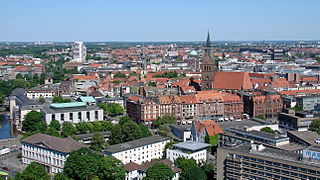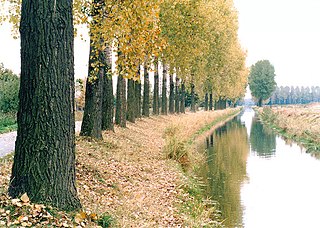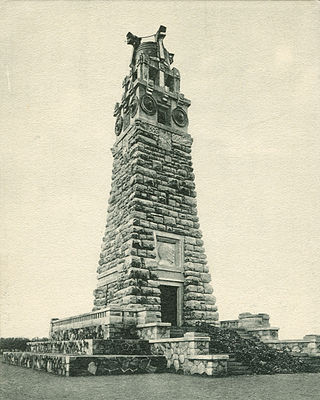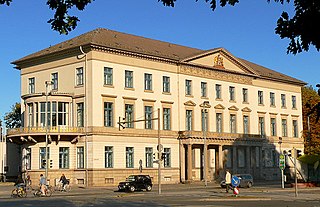
Hanover is a town located along the Connecticut River in Grafton County, New Hampshire, United States. As of the 2020 census, its population was 11,870. The town is home to the Ivy League university Dartmouth College, the U.S. Army Corps of Engineers Cold Regions Research and Engineering Laboratory, and Hanover High School. The Appalachian Trail crosses the town, connecting with a number of trails and nature preserves.

Hanover is the capital and largest city of the German state of Lower Saxony. Its 535,932 (2021) population makes it the 13th-largest city in Germany as well as the fourth-largest city in northern Germany after Berlin, Hamburg and Bremen. Hanover's urban area comprises the towns of Garbsen, Langenhagen and Laatzen and has a population of about 791,000 (2018). The Hanover Region has approximately 1.16 million inhabitants (2019) and is the largest in the Hanover–Braunschweig–Göttingen–Wolfsburg Metropolitan Region, the 17th biggest metropolitan area by GDP in the European Union.

Lower Saxony is a German state in northwestern Germany. It is the second-largest state by land area, with 47,614 km2 (18,384 sq mi), and fourth-largest in population among the 16 Länder federated as the Federal Republic of Germany. In rural areas, Northern Low Saxon and Saterland Frisian are still spoken, albeit in declining numbers.

The Aller is a 215-kilometre-long (134 mi) river in the states of Saxony-Anhalt and Lower Saxony in Germany. It is a right-hand, and hence eastern, tributary of the Weser and is also its largest tributary. Its last 117 kilometres (73 mi) form the Lower Aller federal waterway. The Aller was extensively straightened, widened and, in places, dyked, during the 1960s to provide flood control of the river. In a 20-kilometre-long (12 mi) section near Gifhorn, the river meanders in its natural river bed.
Hanover Region is a district in Lower Saxony, Germany. It is bounded by the districts of Heidekreis, Celle, Gifhorn, Peine, Hildesheim, Hameln-Pyrmont, Schaumburg and Nienburg.

Sprengel Museum is a museum of modern art in Hanover, Lower Saxony, holding one of the most significant collections of modern art in Germany. It is located in a building situated adjacent to the Masch Lake approximately 150 metres (490 ft) south of the state museum. The museum opened in 1979, and the building, designed by Peter and Ursula Trint and Dieter Quast, was extended in 1992.

The Duchy of Brunswick was a historical German state that ceased to exist in 1918. Its capital was the city of Brunswick. It was established as the successor state of the Principality of Brunswick-Wolfenbüttel by the Congress of Vienna in 1815. In the course of the 19th-century history of Germany, the duchy was part of the German Confederation, the North German Confederation and from 1871 the German Empire. It was disestablished after the end of World War I, its territory incorporated into the Weimar Republic as the Free State of Brunswick.

Garbsen is a town in the district of Hanover, in Lower Saxony, Germany. It is situated on the river Leine, approx. 11 km northwest of Hanover. The name Garbsen can be traced back to 1223. Today's 13 city districts have partly developed independently until the city of Garbsen was formed within its current boundaries during the regional reform in 1974.

The Herrenhausen Gardens of Herrenhausen Palace are located in Herrenhausen, an urban district of Hanover, the capital of Lower Saxony, Germany. Dating to the era of the Kings of Hanover, they comprise Great Garden, Hill Garden, Georgen Garden and Guelf Garden.
Johann Gottfried Heinrich Kirchweger was a German railway engineer. Heinrich Kirchweger was born on 12 June 1809 in Stettin, then part of the Kingdom of Prussia, now Szczecin in Poland. After attending the trade school in Berlin, Kirchweger worked with the industrialist Georg Henschel in Kassel.

The Hanoverian Moor Geest is a gently rolling landscape between Hanover and Nienburg in the German state of Lower Saxony covering an area of around 800 square kilometres (310 sq mi). It belongs to the raised bog regions of northwest Germany, which cover the geest terrain formed during the ice age and which stretch from the Netherlands to the eastern border of Lower Saxony. The geest tract on the Hanoverian Moor Geest consists of a ground moraine plateau with a height of 50–85 metres (164–279 ft) above sea level that is dominated by bog. Its natural boundaries are the Aller glacial valley to the north and the Burgdorf-Peine Geest to the east.

The Calenberg is a hill in central Germany in the Leine depression near Pattensen in the municipality of Schulenburg. It lies 13 km west of the city of Hildesheim in south Lower Saxony on the edge of the Central Uplands. It is made from a chalk marl slab (Kalkmergelbank), has a height of 70 m above NN and was formed almost 100 million years ago at the beginning of the Upper Cretaceous series in Cenomanian stage. The Calenberg became historically important as a result of the fort, stronghold and castle built as the main residence of the House of Hanover.

Calenberg Castle was a medieval lowland castle in central Germany, near Schulenburg in the borough of Pattensen, 13 kilometres (8.1 mi) west of the city of Hildesheim. It was built as a water castle in 1292 by the Welf duke, Otto the Strict, in der Leine river meadows between two branches of the Leine river on the southern part of the chalk marl hill of the Calenberg. At the start of the 16th century it was converted into a fort (Feste). In the 15th century, Fort Calenberg gave its name to the Welf Principality of Calenberg. Following the Thirty Years' War it lost its military importance and was slighted. Today it is a ruin with underground vaults that are surrounded by high ramparts.
The Lower Saxon Department for Water, Coastal and Nature Conservation (NLWKN) is a department of the state of Lower Saxony, with its headquarters in Norden (Ostfriesland) and is responsible to the Minister for the Environment and Climate Protection.

The Red Thread is a 4.2-kilometre (2.6 mi) urban walking trail in Hanover, Germany, to 36 significant points of interest about architecture and the history of the city centre.

The Bismarck Tower in Hanover, Germany was a tower erected as a monument to the first Chancellor of the united German nation Otto von Bismarck for patriotic and nationalistic purposes, which then became a hub for national socialist events in the city until its dismantlement in 1935 as part of the building of the Maschsee.
Sülbeck is one of the oldest villages in the town of Einbeck, district Northeim. The development of the village is connected to the saline springs. These were used to produce brine and salt for some hundred years.

Nordstemmen station is located on the Hanover–Göttingen railway and the Hildesheim–Löhne railway in the town of Nordstemmen in the German state of Lower Saxony. The station building, constructed by Conrad Wilhelm Hase between 1853 and 1854, has not been used by Deutsche Bundesbahn nor Deutsche Bahn since 1977. Since 2011, the Hildesheim contractor Dirk Bettels has tried in vain to acquire and rehabilitate the grade II heritage-listed station building with public funds. Construction work begun by Dirk Bettels was discontinued at the end of March 2013 because no contract had been signed by Deutsche Bahn.
The Saw-Killer of Hanover is the name of an unidentified German serial killer, who is supposedly responsible for murdering and dismembering at least four women and two men, whose body parts were found in Hanover and the surrounding area in the 1970s. None of the victims have been identified, and the case is also referred to as The Found Corpses of Hanover. The "SOKO Torso" Unit of the Hanoverian police, directed by Commissioner Günter Nowatius, investigated the murders at the time.

Wangenheim Palace is a building in the Mitte district of Hanover, the capital of Lower Saxony, Germany. From 1863 to 1913, it was the town hall and seat of the city's administration. Today it is the seat of the Lower Saxon Ministry of Economic Affairs.



























